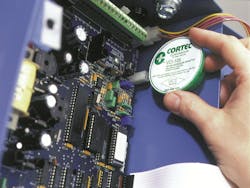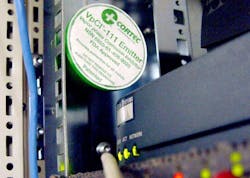Cortec Emitters Are for Corrosion Protection in Non-Ventilated Enclosures
Cortec Corporation’s patented devices aim to safeguard metal parts and electronic equipment against corrosion in non-ventilated enclosures. Their ability to emit Vapor phase Corrosion Inhibitors (VpCI) ensures a protective molecular layer over all metal surfaces, even in adverse conditions such as high humidity, salt spray and airborne contaminants.
Suitable for enclosures up to 5 cubic feet, the VpCI-105 is made to be compact with a breathable Tyvek membrane that controls the release of inhibitors. Applications include packaging electrical gear, marine electronics, aerospace controls, medical equipment and toolboxes. It is made to be easy to install, safe and effective for up to 24 months.
The VpCI-111 is made for larger enclosures up to 11 cubic feet. It also has a breathable Tyvek membrane that forms a molecular barrier on critical electronic and metal parts, protecting during operation, shipping or storage. Applications include sensitive electronics systems in marine, aerospace, military and industrial settings, offering protection for up to 24 months and compatibility with food processing environments and NATO standards.
Both emitters have self-adhesive backs for quick installation and can be positioned in any orientation within enclosures. Users are advised to replace the emitters periodically or after heavy maintenance cycles.
The emitters are free from nitrites, halogens and phosphates, and compliant with environmental standards such as California’s Clean Air Act. The company says they are safe to handle and do not interfere with electrical or optical performance.
Machine Design had some follow-up questions about the emitters, so we reached out to Lisa Marston, project engineer at Cortec Corporation.
Editor’s note: Questions and answers may be edited for style and clarity.
Machine Design: What design challenges do these emitters aim to address, and how do they facilitate problem-solving for MD’s audience of design and mechanical multidisciplinary engineers?
Lisa Marston: Corrosion risk is always present, whether we can see it or not. Often, it is not until the result of corrosive attack is visible that a solution is put in place to control it. Corrosion on critical components can lead to early failures and disruptions in equipment and processes that require immediate attention. Cortec’s emitters are designed for easy application and maintenance to provide robust corrosion protection that can be implemented right away to protect assets from the point of installation and startup.
MD: Can you explain the user experience and interface of the emitters as they pertain to MD’s audience—what makes them intuitive or user friendly?
LM: Cortec manufactures emitters with Vapor phase Corrosion Inhibitors in a variety of formats and sizes to meet the needs of unique applications. Users simply need to select the product, calculate the dosage based on the volume to be protected and install the emitters. Most emitters can provide protection for up to two years, making the replacement schedule easy to implement. The protective VpCIs form an invisible layer on metal surfaces, leading to easy removal when needed.
MD: What are the sustainability features of the emitters, and how do they contribute to eco-friendly design practices?
LM: Cortec has several options for emitters that are designed with the circular economy in mind, utilizing biobased materials and/or recyclable materials. The entire practice of controlling corrosion is also a key sustainability target—by extending the life of components and equipment, we are able to mitigate the need for replacements to be manufactured, saving on energy and materials through all stages of the process.
MD: Can you talk about any use cases or applications that our audience can consider in relation to the emitters?
LM: Anywhere that metal is used, corrosion inhibitors are needed to prolong the life of that metal component. Cortec emitters are commonly used in applications including shipping and storage of critical spares, valves, pipe spools, tanks, skids, pumps and refinery equipment. In service, Cortec emitters are used in electrical enclosures and junction boxes. Smaller-format emitters are commonly found in packages of small but sensitive multi-metal components that will be stored or shipped.
MD: Is there anything else that our engineering audience should know about the emitters that would be helpful for them to do their jobs?
LM: Cortec emitters are available in a variety of formats. These include breathable cups with adhesive to easily stick inside of enclosures (VpCI-105 and VpCI-111), as well as in pouches for larger enclosures, foam and biobased foam pads with customizable sizes, recyclable paper, and flexible tube strips for small-diameter tubing and piping, among other formats.
About the Author
Sharon Spielman
Technical Editor, Machine Design
As Machine Design’s technical editor, Sharon Spielman produces content for the brand’s focus audience—design and multidisciplinary engineers. Her beat includes 3D printing/CAD; mechanical and motion systems, with an emphasis on pneumatics and linear motion; automation; robotics; and CNC machining.
Spielman has more than three decades of experience as a writer and editor for a range of B2B brands, including those that cover machine design; electrical design and manufacturing; interconnection technology; food and beverage manufacturing; process heating and cooling; finishing; and package converting.
Email: [email protected]
LinkedIn: @sharonspielman
Facebook: Machine Design
YouTube: @MachineDesign-EBM



